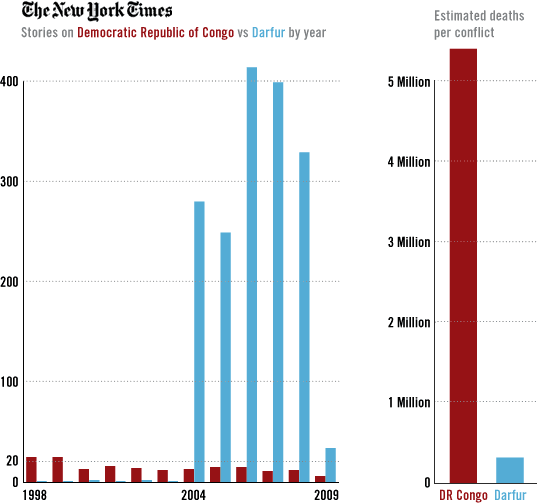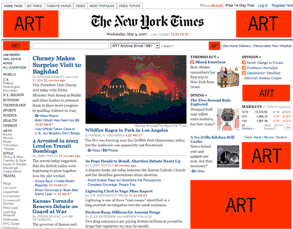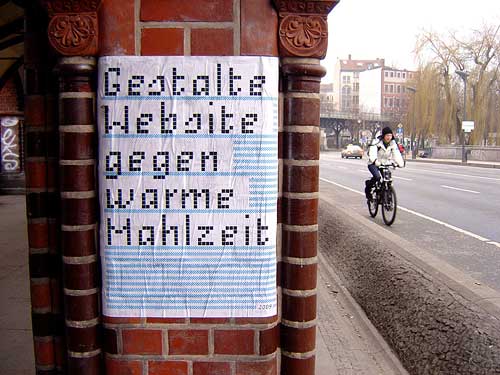February 2009
The Invisible War
On February 21, 2009 Bob Herbert published a column in the New York Times calling the war in the Democratic Republic of Congo “The Invisible War.” After a decade of bloodshed, millions killed and displaced, and an active UN peacekeeping force, why is Africa’s World War so invisible? He actually doesn’t speculate.
Perhaps Mr. Herbert should inquire at the editorial desk. Using the NY Times Article Search API I ran a query by year on the term “Democratic Republic of Congo.” The Times averaged 13.5 stories per year on DR Congo from 1998 through 2008. On the face of it, one story per month seems a nice steady focus. But by comparison, the Times published an average 151.6 stories on Darfur per year during the same period — even though the war in Darfur only started in 2003. In January 2008, the International Rescue Committee published a study reporting the war in DR Congo had claimed 5.4 million lives. In March 2008, the UN estimated the number of deaths in Darfur at 300,000.
Here are the counts of New York Times articles by year, as of February 24, 2009:
| 1998 | 1999 | 2000 | 2001 | 2002 | 2003 | 2004 | 2005 | 2006 | 2007 | 2008 | 2009 | |
| On DR Congo | 24 | 24 | 12 | 15 | 13 | 11 | 12 | 14 | 14 | 10 | 11 | 5 |
| On Darfur | 0 | 0 | 1 | 0 | 1 | 0 | 279 | 248 | 413 | 398 | 328 | 33 |
And a graphic I designed to illustrate it:

For those inclined, here’s the perl script I used to query the API. It borrows heavily from this example.
I realize one should be wary of comparing casualty data gathered with different methodologies, and that the conflict in DR Congo has a five year lead. But a million here, a million there, the disparity is still dramatic.
So why does Darfur get so much more coverage than DR Congo? Do the Arab Muslim bad guys in Sudan make a more convenient target for Western Islamophobes? Are China’s competing industrial interests in Sudan easier to finger than US corporate interests in DR Congo? Are the deserts of Darfur simply more accessible than the forests of Northeastern Congo? Or is Darfur a simpler story with clearer victims and perpetrators? A story closer to Western ideas of genocide than Congo’s messier regional war? Certainly the celebrity and NGO pressure on Darfur has helped. I should note that I’m emphatically not arguing that Darfur should be covered less, but that the war in DR Congo should be covered more. Much more.
Update 2/26/2009 — Anneke Van Woudenberg, Senior Researcher at Human Rights Watch sends this response:
“This comparison is both interesting and disturbing. In my ten years of working on Congo I have often wondered why it gets so much less press attention. The difficulties for journalists to get around and the expense of such trips contribute to the problem, but such problems also occur in Darfur or other conflicts that receive more press coverage. The complexities of the Congo conflict - the alphabet soup of armed groups and the constant changing alliances - make it a challenging story to cover. But it is not impossible. So what is it?
I fear that the Congo conflict receives less coverage because many outsiders have bought into the preconception that Congo is the ‘heart of darkness’ as characterized by Joseph Conrad's book by the same title. The book has often been used to refer to Congo’s plight today, as if the country is somehow predisposed to dark atrocities and violence, and hence there is nothing new to report. Yet many have misunderstood the real message of Conrad's book. It is not Congolese barbarism but rather the greed of outsiders that have plagued this country's history. As the narrator of Conrad's book describes, he found in Congo, ‘the vilest scramble for loot that ever disfigured the history of human conscience.’ A situation little changed today. Surely that story is worthy of further press coverage.”
Update 4/16/2009 — Julie Hollar at FAIR points out that The New York Times style does not always refer to DR Congo as “Democratic Republic of Congo,” rather sometimes just “Congo,” which makes the free text search problematic. Instead, I ran an API search for articles by geo tag, comparing documents tagged CONGO (FORMERLY ZAIRE) with documents tagged DARFUR (SUDAN).

By geo tag, Darfur still shows roughly double the coverage of DR Congo. Not quite as dramatic as my first graph, but still disproportionate. Of course this method depends on the Times for accurate tagging of their own articles. It’s unclear why a free text search for “Darfur” turns up so many more results than the geo tag search.

A good yarn, beautifully rendered. But like this previously blogged infographic, it focuses on the financial machinery more than the legal chicanery that got us here.

Cartographies
 Some notes.
Some notes.
Critical Cartography
Reading geography and maps as sites of power, deconstructing assumptions and political implications of maps. See http://en.wikipedia.org/wiki/Critical_cartography, Siam Mapped, Spaces of Capital
Radical Cartography
Using and creating maps to challenge power and facilitate social change, often characterized by an oppositional, anti-authoritarian politics. See An Atlas of Radical Cartography, NYC Guide to War Profiteers, Million Dollar Blocks.
Counter Cartography
Producing maps that challenge the dominant, mainstream narrative of a site or history, often from an explicitly political or activist perspective or from the point of view of historically marginalized communities. See DisOrientation Guide, CrashStat, A Threat to Peace, Notes for a People’s Atlas of Chicago.
Community Cartography
Maps produced collaboratively by a geographically local community, often used to promote a social agenda. See Green Map Systems, Asset Mapping, Aboriginal Mapping Network.
Futurismus
People turned out by the hundreds of thousands to protest the US invasion of Iraq. Why aren’t they in the streets about the financial collapse? Perhaps it hasn’t quite sunk in for some?
A series of street posters in Berlin help envision the struggles to come.

Will Offer Web Design for Hot Meals

Left: “You took to the streets with a sign around your neck: hungry, looking for work, will do anything.”
Right: “Do you remember how on the next day I stood in front of the car in suit and tie and had to sell it?”
Via Just Seeds I found this condescending story in the LA Times. But it’s interesting nonetheless: “Baret, who like his fellow insurgents is a veteran defendant, had refused to pay the $58 fine. His lawyer argued that his actions were less destructive than the 57,000 giant signs that fill the train stations of France.... ‘The advertising budget in France is $39 billion a year.... That’s equivalent to the entire education budget in France.... Our movement goes a lot further than a simple symbolic gesture. And that’s what we want the public to understand.’”
This two-pronged attack on aggressive advertising, fighting with both graffiti and law, seems to be a growing pattern, a combination of legal and extra-legal civil disobedience (with a dash of spectacle) in the battle over what constitutes public space.
Heel the World
“This is a farewell kiss, you dog. This is from the widows, the orphans and those who were killed in Iraq.”
 On January 29, 2009, sculptor Laith al-Amiri unveiled an outsized monument of a shoe in Tikrit to commemorate journalist Muntadhir al-Zaidi who hurled his shoes at President George W. Bush. The sculpture was unveiled on the grounds of an orphanage and constructed with the help of the kids. Officials removed it the following day. The local deputy governor told CNN: “We will not allow anyone to use the government facilities and buildings for political motives.”
On January 29, 2009, sculptor Laith al-Amiri unveiled an outsized monument of a shoe in Tikrit to commemorate journalist Muntadhir al-Zaidi who hurled his shoes at President George W. Bush. The sculpture was unveiled on the grounds of an orphanage and constructed with the help of the kids. Officials removed it the following day. The local deputy governor told CNN: “We will not allow anyone to use the government facilities and buildings for political motives.”- On February 3, 2009, a protester was arrested in the UK for throwing a shoe at the Chinese premier, Wen Jiabao, at a lecture at Cambridge University. As he threw the shoe, the man shouted, “How can you listen to this unchallenged?”
- For every pair purchased, TOMS Shoes donates a pair of shoes to a child in a developing country. From May 2006 through December 2008, TOMS distributed 115,000 pairs of shoes worldwide. Shoes prevent Podoconiosis, a disease caused by absorption of silica through the feet, particularly from volcanic soil. The symptoms are swelling, ulcers, and ultimately deformity in the feet and legs. The disease is 100% preventable by wearing shoes.
- The Shoe Bank collects used shoes at schools, gyms and stores around Texas and redistributes them at shelters in Texas and to natural disaster victims abroad. The organization provides shoes for twenty thousand people every year. In September 1991, The Shoe Bank was officially recognized by President George H. W. Bush.

